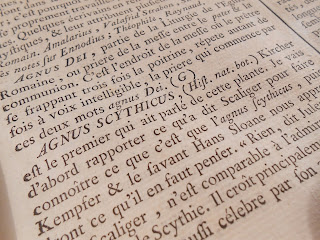 |
| Rauner's Paradisi in Sole... |
At that, our book nerd senses tingled. We set off in search of the Lamb of Tartary in our collections to find out what it was.
Edward Topsell, in his 1607 Historie of Fovre-Footed Beasts, writes that in "Muscovy" near the Volga, there is a "certaine beast of the quantity and forme of a little Lamb, the people call it Boranz ... [that is] generated out of the earth like a reptile creature ... [and is] thus lieth a litle [sic] while and neuer stirreth far from the place it is bred in, I mean it is not able to moue it selfe, but eateth vp all the grasse & green things that it can reach, and when it can find no more, then it dyeth." He cites "Sigismundus," Topsell's anglicized name for Sigismund von Herberstein (1486-1566), a Hapsburg nobleman and diplomat who wrote the first account of Russia widely known in Western Europe, Notes on Muscovite Affairs (1549). Von Herberstein was known for his accuracy, refusing to record anything unless it had been corroborated by multiple sources.
The legend of the Vegetable Lamb endured through the Enlightenment. Denis Diderot (1713-1784) was the co-founder, co-editor and author for the 18-volume Encyclopédie, ou dictionnaire raisonné des sciences, des arts et des métiers, one of the foundational Enlightenment texts. Published over a period of 21 years (1751 to 1772), the Encyclopedia was meant to change the way humans thought. The entry on the "Agnus Scythicus" (Scythian Lamb) describes the Lamb -- which was probably a misunderstood plant -- and then immediately launches into a diatribe about truth. "All the wonder of the Scythian lamb reduced to nothing, or at least to very little, to a hairy root which people twist and turn to make it look a little like a lamb."
 |
| "Agnus Scythicus" entry in Diderot's work |
Today, most historians agree with Diderot, and cite the wooly fern Ciborium barometz as the inspiration for the legend.
For Topsell, ask for Rare Book QL41 .T66 1607. John Parkinson's Paradisi in Sole Paradisus Terrestris is Val 635 P229p. Diderot's
is Rare Book AE25 .E53 (18 vols.) Luckily for those of us who don't speak French, the University of Michigan has translated the entries into English (Scythian Lamb, cited above).
No comments :
Post a Comment